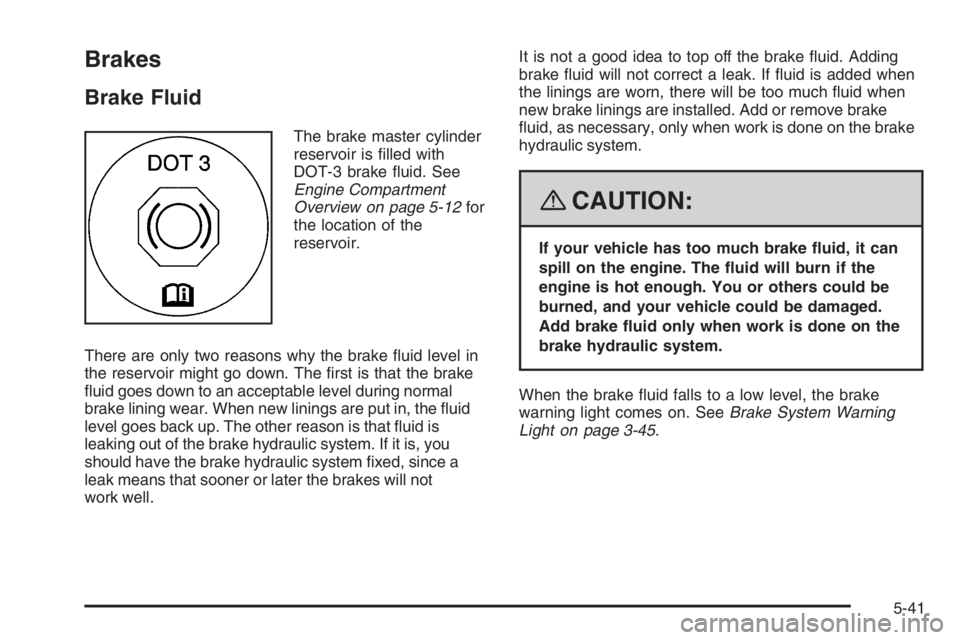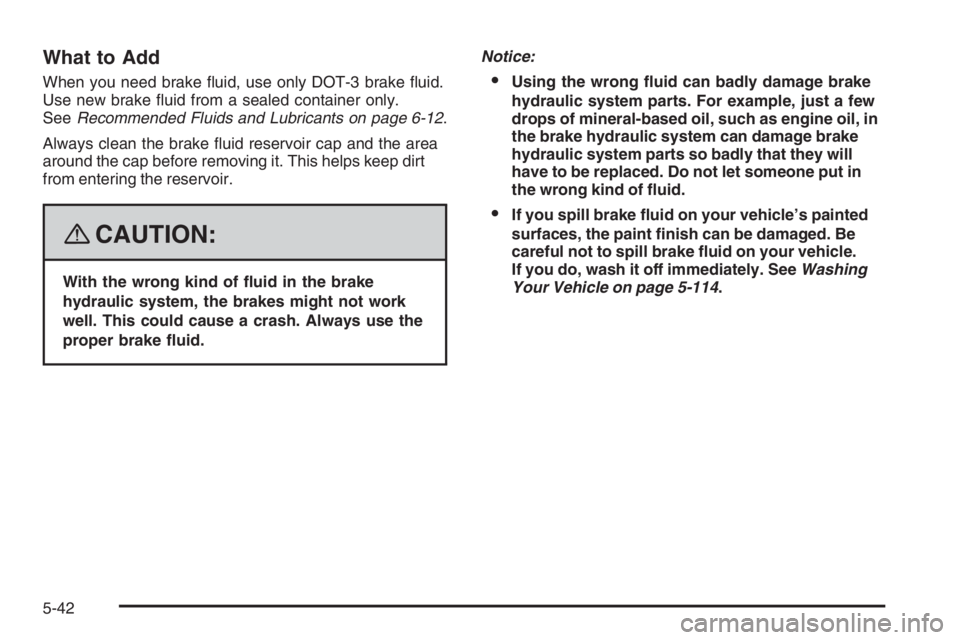Page 281 of 450
Hood Release
To open the hood, do the following:
1. Pull the hood release handle with this symbol on
it. It is located inside the vehicle near the parking
brake pedal.2. Go to the front of the vehicle and release the
secondary hood latch, located near the center
front of the engine compartment, by moving it to
the right.
3. Lift the hood.
Before closing the hood, be sure all the �ller caps are
on properly. Then pull the hood down and close it �rmly.
5-11
Page 283 of 450

A. Windshield Washer Fluid Reservoir. See “Adding
Washer Fluid” underWindshield Washer Fluid
on page 5-40
B. Battery. SeeBattery on page 5-45.
C. Remote Positive (+) Terminal. SeeJump Starting on
page 5-46.
D. Passenger Compartment Air Filter. SeePassenger
Compartment Air Filter on page 3-36.
E. Underhood Fuse Block. SeeUnderhood Fuse Block
on page 5-124.
F. Engine Coolant Recovery Tank. SeeCooling System
on page 5-30.
G. Pressure Cap. SeePressure Cap on page 5-27.
H. Power Steering Fluid Reservoir (Out of View). See
Power Steering Fluid on page 5-39.I. Electric Engine Cooling Fans. SeeCooling System
on page 5-30.
J. Engine Oil Dipstick. See “Checking Engine Oil”
underEngine Oil on page 5-15.
K. Engine Oil Fill Cap. See “When to Add Engine Oil”
underEngine Oil on page 5-15.
L. Automatic Transmission Fluid Dipstick. See
“Checking the Fluid Level” underAutomatic
Transmission Fluid on page 5-22.
M. Engine Coolant Bleed Valve. See “How to Add
Coolant to the Radiator” underCooling System on
page 5-30.
N. Brake Master Cylinder Reservoir. See “Brake Fluid”
underBrakes on page 5-41.
O. Engine Air Cleaner/Filter. SeeEngine Air
Cleaner/Filter on page 5-20.
5-13
Page 285 of 450

A. Windshield Washer Fluid Reservoir. See “Adding
Washer Fluid” underWindshield Washer Fluid
on page 5-40.
B. Battery. SeeBattery on page 5-45.
C. Underhood Fuse Block. SeeUnderhood Fuse Block
on page 5-124.
D. Remote Positive (+) Terminal. SeeJump Starting on
page 5-46.
E. Pressure Cap. SeePressure Cap on page 5-27.
F. Power Steering Fluid Reservoir. SeePower Steering
Fluid on page 5-39.
G. Engine Oil Dipstick. See “Checking Engine Oil”
underEngine Oil on page 5-15.
H. Engine Oil Fill Cap. See “When to Add Engine Oil”
underEngine Oil on page 5-15.
I. Automatic Transmission Fluid Dipstick. See
“Checking the Fluid Level” underAutomatic
Transmission Fluid on page 5-22.
J. Brake Master Cylinder Reservoir. See “Brake Fluid”
underBrakes on page 5-41.
K. Engine Air Cleaner/Filter. SeeEngine Air
Cleaner/Filter on page 5-20.
L. Engine Coolant Recovery Tank. SeeCooling System
on page 5-30.Engine Oil
Checking Engine Oil
It is a good idea to check the engine oil every time you
get fuel. In order to get an accurate reading, the oil
must be warm and the vehicle must be on level ground.
The engine oil dipstick handle is a yellow loop. See
Engine Compartment Overview on page 5-12for
the location of the engine oil dipstick.
1. Turn off the engine and give the oil several minutes
to drain back into the oil pan. If you do not do this,
the oil dipstick might not show the actual level.
2. Pull out the dipstick and clean it with a paper towel
or cloth, then push it back in all the way. Remove it
again, keeping the tip down, and check the level.
5-15
Page 293 of 450

Checking the Fluid Level
Prepare the vehicle as follows:
1. Park the vehicle on a level place. Keep the engine
running.
2. With the parking brake applied, place the shift lever
in PARK (P).
3. With your foot on the brake pedal, move the shift
lever through each gear, pausing for about three
seconds in each one. Then, position the shift lever
in PARK (P).
4. Let the engine run at idle for three to �ve minutes.
Then, without shutting off the engine, follow these steps:
The transmission �uid
dipstick handle has this
symbol on it, and is located
near the rear of the
engine compartment.SeeEngine Compartment Overview on page 5-12for
more information on location.
1. Pull out the dipstick and wipe it with a clean rag or
paper towel.
2. Push it back in all the way, wait three seconds and
then pull it back out again.
3. Check both sides of the dipstick, and read the
lower level. The �uid level must be in the
crosshatched area.
4. If the �uid level is in the acceptable range, push the
dipstick back in all the way.
How to Add Automatic Transmission
Fluid
Refer to the Maintenance Schedule to determine what
kind of transmission �uid to use. SeeRecommended
Fluids and Lubricants on page 6-12.
5-23
Page 311 of 450

Brakes
Brake Fluid
The brake master cylinder
reservoir is �lled with
DOT-3 brake �uid. See
Engine Compartment
Overview on page 5-12for
the location of the
reservoir.
There are only two reasons why the brake �uid level in
the reservoir might go down. The �rst is that the brake
�uid goes down to an acceptable level during normal
brake lining wear. When new linings are put in, the �uid
level goes back up. The other reason is that �uid is
leaking out of the brake hydraulic system. If it is, you
should have the brake hydraulic system �xed, since a
leak means that sooner or later the brakes will not
work well.It is not a good idea to top off the brake �uid. Adding
brake �uid will not correct a leak. If �uid is added when
the linings are worn, there will be too much �uid when
new brake linings are installed. Add or remove brake
�uid, as necessary, only when work is done on the brake
hydraulic system.
{CAUTION:
If your vehicle has too much brake �uid, it can
spill on the engine. The �uid will burn if the
engine is hot enough. You or others could be
burned, and your vehicle could be damaged.
Add brake �uid only when work is done on the
brake hydraulic system.
When the brake �uid falls to a low level, the brake
warning light comes on. SeeBrake System Warning
Light on page 3-45.
5-41
Page 312 of 450

What to Add
When you need brake �uid, use only DOT-3 brake �uid.
Use new brake �uid from a sealed container only.
SeeRecommended Fluids and Lubricants on page 6-12.
Always clean the brake �uid reservoir cap and the area
around the cap before removing it. This helps keep dirt
from entering the reservoir.
{CAUTION:
With the wrong kind of �uid in the brake
hydraulic system, the brakes might not work
well. This could cause a crash. Always use the
proper brake �uid.Notice:
Using the wrong �uid can badly damage brake
hydraulic system parts. For example, just a few
drops of mineral-based oil, such as engine oil, in
the brake hydraulic system can damage brake
hydraulic system parts so badly that they will
have to be replaced. Do not let someone put in
the wrong kind of �uid.
If you spill brake �uid on your vehicle’s painted
surfaces, the paint �nish can be damaged. Be
careful not to spill brake �uid on your vehicle.
If you do, wash it off immediately. SeeWashing
Your Vehicle on page 5-114.
5-42
Page 313 of 450

Brake Wear
Your vehicle has disc brakes. Disc brake pads have
built-in wear indicators that make a high-pitched warning
sound when the brake pads are worn and new pads are
needed. The sound can come and go or be heard all the
time your vehicle is moving, except when you are pushing
on the brake pedal �rmly.
{CAUTION:
The brake wear warning sound means that
soon the brakes will not work well. That could
lead to an accident. When you hear the brake
wear warning sound, have your vehicle
serviced.Notice:Continuing to drive with worn-out brake
pads could result in costly brake repair.
Some driving conditions or climates can cause a brake
squeal when the brakes are �rst applied or lightly
applied. This does not mean something is wrong with
the brakes.
Properly torqued wheel nuts are necessary to help
prevent brake pulsation. When tires are rotated, inspect
brake pads for wear and evenly tighten wheel nuts in
the proper sequence to torque speci�cations in
Capacities and Specifications on page 5-128.
Brake linings should always be replaced as complete
axle sets.
5-43
Page 314 of 450

Brake Pedal Travel
See your dealer/retailer if the brake pedal does not
return to normal height, or if there is a rapid increase in
pedal travel. This could be a sign that brake service
might be required.
Brake Adjustment
Every time you apply the brakes, with or without the
vehicle moving, the brakes adjust for wear.
Replacing Brake System Parts
The braking system on a vehicle is complex. Its many
parts have to be of top quality and work well together if
the vehicle is to have really good braking. Your vehicle
was designed and tested with top-quality brake parts.
When you replace parts of the braking system — for
example, when the brake linings wear down and you
need new ones put in — be sure you get new approved
replacement parts. If you do not, the brakes might not
work properly. For example, if someone puts in brake
linings that are wrong for your vehicle, the balance
between the front and rear brakes can change — for the
worse. The braking performance you have come to
expect can change in many other ways if someone puts
in the wrong replacement brake parts.
5-44